#exanimate
Text
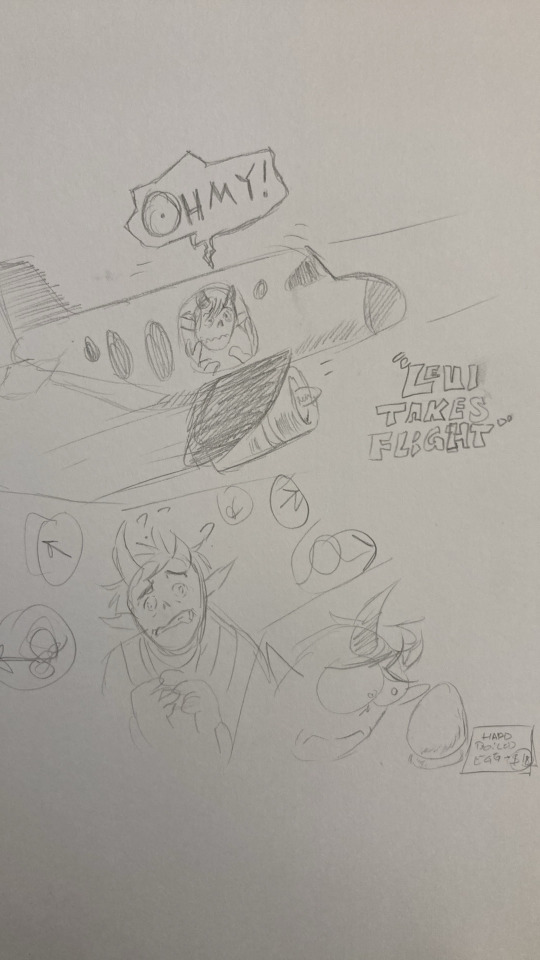
Levi if he had to fly around and navigate the airport
(May or may not be based on actual events)
#levi morris#exanimate#personal project#sketchbook#sketches#sketch#pencil sketch#doodle#scribbles#scrabbles
3 notes
·
View notes
Text




I got a few asks in my inbox for some more exanimate stuff (specifically s2e12) and it's been a while sooo here!
#hooray im not dead#inanimate insanity#inanimate insanity au#ii au#exanimate insanity#ii lightbulb#lightbulb ii#ii paintbrush#paintbrush ii#ii balloon#balloon ii#ii nickel#nickel ii#ii knife#knife ii#ii microphone#microphone ii#ii test tube#test tube ii#ii fan#fan ii#osc#object show#object show community#bfdi#relpyart
1K notes
·
View notes
Text
dumb joke and also an excuse to draw a bunch of nickels!

Divorce Swap is by maxphilippa and @burgycreeper405-blog
GKGG is by @maxphilippa
IISwap is by me! Lol
Exanimate Insanity is by @puppyrelp
IIShift is by @velvelic
yeah i had a little too much fun with this dumb joke
#rocket talk#roc save#art#my art#nickel ii#ii nickel#balloon ii#ii balloon#inanimate insanity#ii divorce swap au#ii gkgg au#inanimate insaniswap#iiswap#iiswap au#exanimate insanity#insaniswap insanity#iishift#inanimate insanishift#so many tags........
97 notes
·
View notes
Text

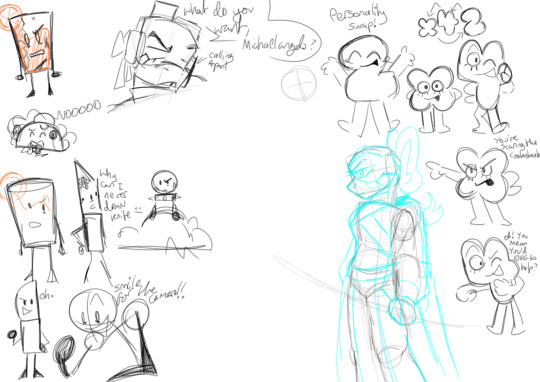


HEY GUYS!!
Sorry I've been so inactive lmao, GCSE's go wild. BUT GUESS WHO'S OFFICIALLY DONE WITH EXAMS!!!
I haven't done much art recently, but I'll try get into the habit of posting more of it now that I'm done with my exams ::D
#my art#undertale#undertale au#sans au#sans the skeleton#sans#sans undertale#art#doodles#inanimate insanity#but in doodle form#theres some exanimate insanity in there#or whatever the swap ii au is called#swap ii#two bfdi#x bfdi#four bfdi#animatic ab
22 notes
·
View notes
Text
recreated my favorite ii scene of all time as swap au <3 @puppyrelp


#exanimate insanity#inanimate insanity#inanimate insanity au#inanimateswap#ii au#ii test tube#ii fan
40 notes
·
View notes
Text
EXAMIMATE INSANITY I OOVE THIS AU
au from @puppyrelp
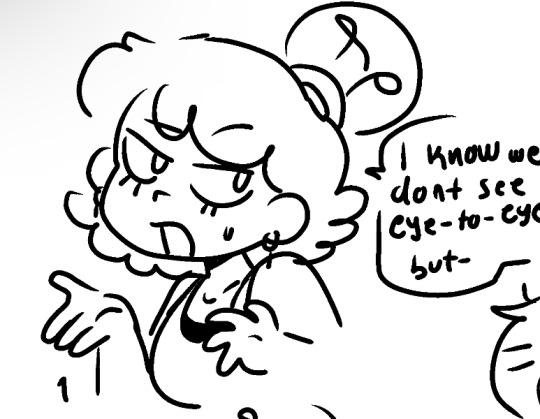
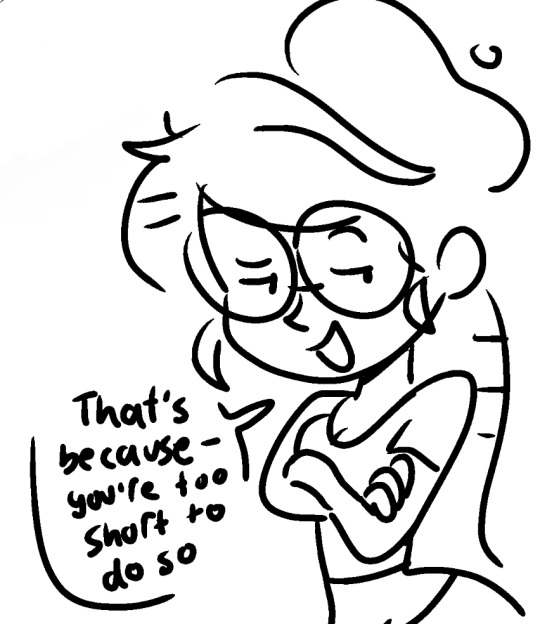



I lobe thrse 4
I made my own human designs <3
#inanimate insanity#ii lightbulb#ii paintbrush#ii fan#ii test tube#YGH I LOVEV THEM#exanimate insanity
28 notes
·
View notes
Text
Hi i usually create things for Thomas The Tank Engine but never mind that
Hi @puppyrelp i heard that you didn't rlly swap MePad and Toilet bcus it wouldn't make sense plotwise so I made this for fun

Info:
MePad was saved by MePhone4S, and was inactive for a while. When Brian called MePhone, he said that he was now active. 4S was disappointed at what he took along the way in his escape. MePad was the biggest klutz he had ever met so he always ignored him (let's just say MePad also reminded 4S of himself before)
As an attempt to lie, he stole a toilet from Taco's hotel and claimed it as his assistant, only for the toilet to actually come to life randomly.
MePad is obnoxious, loud, dimwitted and clumsy. He's very proud of his size but feels like a burden to MePhone and doesn't understand why he treats him the way he does.
Toilet is humble because he's only a toilet that floats and appear everywhere. He's clever, respectful and polite. He learned a lot from reading books. Toilet lacks the ability to show a wide array of emotions, leading people to call him emotionless.
In Theft And Battery, MePad opens up about how he views Inanimate Island as his only home but feels ostracized and unwelcomed there because of his treatment.

Toilet gives him a chance to prove himself a useful assistant by making him use his teleporting abilities. It's here we discovered that his abilities actually flawed and he has horrible control over them. Nonetheless, he still saves everyone.
They became very good friends after this


Until Mine Your Own Business.

Toilet steps on the gem and witnessing what MePhone4S meant about “saving MePad”.
Toilet is kidnapped and knocked out in Hatching The Plan.
And yeah that's were we leave it lol I hope you like this ^^
#ii mepad#mepad#inanimate insanity mepad#inanimate insanity#osc#osc art#object show community#ii toilet#ii mephone4s#ii fanart#ii au#inanimate swap#exanimate insanity#art#swap au#role swap au
145 notes
·
View notes
Text

That scene in Hatching the Plan, but it's the Exanimate Insanity AU by @puppyrelp and @madame_insanity (on twitter)!
(Hope you don't mind me tagging you here too!)
#inanimate insanity#exanimate insanity#ii oj#ii knife#ii test tube#pink draws#now for the silly details!#there's a little speech tail thingy coming out of oj's orange slice because it looked silly LKAJSDGLADSG#test tube has no orange/yellow on her because she wasn't a part of the knife-oj alliance#knife's eyes are only shown on the highlights because oohoooohoo i don't know it looks nice#oj has no eyes because he wasn't seen by anyone (in the scene)#knife has no mouth because he wasn't heard by anyone (in general)#and uh test tube is. unconscious. that's why she's. yeah.#and that's all for the silly tags! i just wanted to do a palette challenge LASJKGALSG
163 notes
·
View notes
Note
just wanted to say that as a system with several "scary" nonhuman alters and poorly masked aspd we were elated to find this blog!
Hey, welcome!
I'm glad you enjoy the concept. We're very happy that people relate and feel like this fits them and most of all, that terrorpunk makes them feel seen. Mal, our headmate who made the term, was fed up of being a villain fictive and feeling like tox needed to censor toxicself, plus the fact that especially at the time, societal pressure was weighing on us as a psychotic, disabled trans system. We're very very glad that others find it useful, in short!
Have a great day.
10 notes
·
View notes
Text
Levi had a “good demon” chart. Every time he does a chore, behaves, or helps out around the house he gets a gold star on his chart. 3 stars gets him an hour out of his room, 5 stars gets him a the whole night out of his room, and 10 stars lets him go out of the house for the night (with limited supervision from either Luis or Eliza).
The chart was originally for Reuben, but they stopped when he got older..
16 notes
·
View notes
Note
Who’s swapped with who in inanimate insanity infinite? (Yknow the one with salt and pepper as the Hosts?)
If you look closely at this edit I made and remember the original image, here's it is! (I swapped some of the Infinity cast with the failed s1 debut cast!) (also it's impossible to swap black hole with anyone so it's just a more accurate black hole)
(Put under keep reading cause this is a LONG ass thread, and it's not even done. I'll reblog this post w the rest soon :])
(LEFT - OG / RIGHT - MINE)
Thermos / Cookie




2. Frank / TV (Ex!Frank is like. a hotdog waffle)




3. Chives / Magnifying Glass (honestly forgot what Ex!Chives is supposed to be)




4. Kumquat / Poptart




5. Spiky Mervert / Traffic Light




6. Shell / Bell (get it)




7. Bandana / Teddy Bear (for some reason I didn't swap their poses like a dumbass)




Part two of the thread coming soon!!
#exanimate insanity#inanimate insanity#inanimate insanity infinity#relpyart#inanimate insanity au#inanimateswap
40 notes
·
View notes
Text
Objectober Day 31 - Freestyle! The actual Day 31 piece, too!
(CW: AIB!)
For AIB... Disclaimer: I do not condone or support the actions of the AIB creator. All races deserve to be treated equally and with respect. The only time a singular person of a certain race SHOULDN'T be is if they cause harm, but don't ostracize the whole race.

One character from every show I have drawn during the month in Objectober pieces only! (At least one, that is. A majority have three, but I ran outta room.)
List of characters and where they're from:
Flower, Gelatin, Profily - BFDI. Bow, Bot, and Dough - II. Lemony, Rhythm Rocket, Flaggy - VOO. Button (Bella), Scarfy (Eloise), Caney (Archie) - hfjONE. Pot - EI (designed by @bluie123 !) Tumbleweed - AIB. Coney - OC.
What a nice way to wrap up the month! Woulda thought of something more grand, but whatever. This is fine.
HAPPY HALLOWEEN! 😊
#objectober#objectober 2023#halloween#bfdi#inanimate insanity#aib#cw aib#voo#village of objects#hfjone#object show oc#not tagging all of them#animated inanimate battle#exanimate insanity
20 notes
·
View notes
Text
cyrus, already below half health, accidentally walked through lava during the grym fight trying to reposition himself, took 35 damage, and didn't go down lol
#71 hp at level 6 babyyyyyyyyy#durge!cyrus#also the glowing shield. baby i take back my tags about your effect being meh 8 temp hp is a /great/ buffer for exanimate's glory
4 notes
·
View notes
Text
Did the ancient Celts really paint themselves blue?
Part 2: Irish tattoos



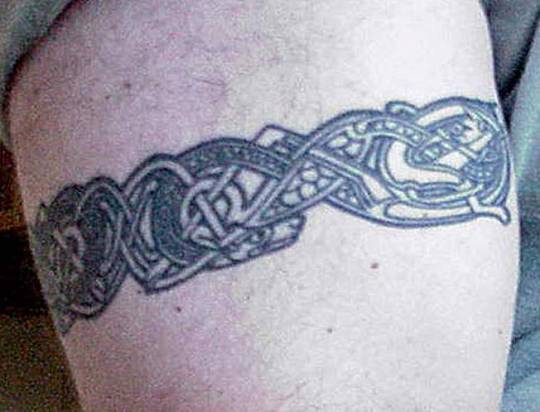
Clockwise from top left: Deirdre and Naoise from the Ulster Cycle by amylouioc, detail from The Marriage of Strongbow and Aoife by Daniel Maclise, a modern Celtic revival tattoo, Michael Flatley in a promotional image for the Irish step dance show 'Lord of the Dance'
This is my second post exploring the historical evidence for our modern belief that the ancient and medieval Insular Celts painted or tattooed themselves with blue pigment. In the first post, I discussed the fact that body paint seems to have been used by residents of Great Britain between approximately 50 BCE to 100 CE. In this post, I will examine the evidence for tattooing.
Once again, I am looking at sources pertaining to any ethnic group who lived in the British Isles, this time from the Roman Era to the early Middle Ages. The relevant text sources range from approximately 200 CE to 900 CE. I am including all British Isles cultures, because a) determining exactly which Insular culture various writers mean by terms like ‘Briton’, ‘Scot’, and ‘Pict’ is sometimes impossible and b) I don’t want to risk excluding any relevant evidence.
Continental Written Sources:
The earliest written source to mention tattoos in the British Isles is Herodian of Antioch’s History of the Roman Empire written circa 208 CE. In it, Herodian says of the Britons, "They tattoo their bodies with colored designs and drawings of all kinds of animals; for this reason they do not wear clothes, which would conceal the decorations on their bodies" (translation from MacQuarrie 1997). Herodian is probably reporting second-hand information given to him by soldiers who fought under Septimius Severus in Britain (MacQuarrie 1997) and shouldn't be considered a true primary source.
Also in the early 3rd century, Gaius Julius Solinus says in Collectanea Rerum Memorabilium 22.12, "regionem [Brittaniae] partim tenent barbari, quibus per artifices plagarum figuras iam inde a pueris variae animalium effigies incorporantur, inscriptisque visceribus hominis incremento pigmenti notae crescunt: nec quicquam mage patientiae loco nationes ferae ducunt, quam ut per memores cicatrices plurimum fuci artus bibant."
Translation: "The area [of Britain] is partly occupied by barbarians on whose bodies, from their childhood upwards, various forms of living creatures are represented by means of cunningly wrought marks: and when the flesh of the person has been deeply branded, then the marks of the pigment get larger as the man grows, and the barbaric nations regard it as the highest pitch of endurance to allow their limbs to drink in as much of the dye as possible through the scars which record this" (from MacQuarrie 1997).
This passage, like Herodian's, is clearly a description of tattooing, not body staining or painting. That said, I have no idea of tattoos actually work like this. I would think this would result in the adult having a faded, indistinct tattoo, but if anyone knows otherwise, please tell me.
The poet Claudian, writing in the early 5th c., is the first to specifically mention the Picts having tattoos (MacQuarrie 1997). In De Bello Gothico he says, "Venit & extremis legio praetenta Britannis,/ Quæ Scoto dat frena truci, ferroque notatas/ Perlegit exanimes Picto moriente figuras."
Translation: "The legion comes to make a trial of the most remote parts of Britain where it subdues the wild Scot and gazes on the iron-wrought figures on the face of the dying Pict" (from MacQuarrie 1997).
Last, and possibly least, of our Mediterranean sources is Isidore of Seville. In the early 7th c. he writes, "the Pictish race, their name derived from their body, which the efficient needle, with minute punctures, rubs in the juices squeezed from native plants so that it may bring these scars to its own fashion [. . .] The Scotti have their name from their own language by reason of [their] painted body, because they are marked by iron needles with dark coloring in the form of a marking of varying shapes." (translation from MacQuarrie 1997)
Isidore is the earliest writer to explicitly link the name 'Pict' to their 'painted' (Latin: pictus) i.e. tattooed bodies. Isidore probably borrowed information for his description from earlier writers like Claudian (MacQuarrie 1997).
In the 8th century, we have a source that definitely isn't Romans recycling old hearsay. In 786, a pair of papal legates visited the Anglo-Saxon kingdoms of Mercia and Northumbria (Story 1995). In their report to Pope Hadrian, the legates condemn pagans who have "superimposed most hideous cicatrices" (i.e gotten tattoos), likening the pagan practice to coloring oneself "with dirty spots". The location of the visit indicates that these are Anglo-Saxon tattoos rather than Celtic, but some scholars have suggested that the Anglo-Saxons might have adopted the practice from the Brittonic Celts (MacQuarrie 1997).
A gloss in the margin of the late 9th c. German manuscript Fulda Aa 2 defines Stingmata [sic] as "put pictures on the bodies as the Irish (Scotti) do." (translation from MacQuarrie 1997).
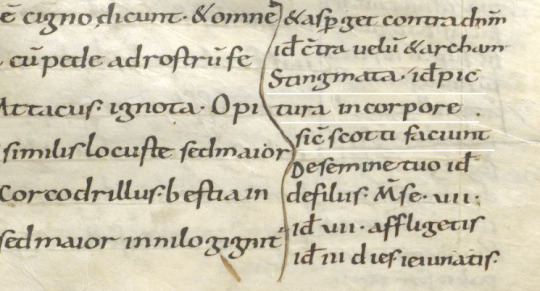
Fulda Aa 2 folio 43r The gloss is on the left underlined in white.
Irish Written Sources:
Irish texts that mention tattoos date to approximately 700-900 CE, although some of them have glosses that may be slightly later, and some of them cannot be precisely dated.
The first text source is a poem known in English as "The Caldron of Poesy," written in the early 8th c. (Breatnach 1981). The poem is purportedly the work of Amairgen, ollamh of the legendary Milesian kings. In the first stanza of the poem, he introduces himself saying, "I being white-kneed, blue-shanked, grey-bearded Amairgen." (translation from Breatnach 1981)
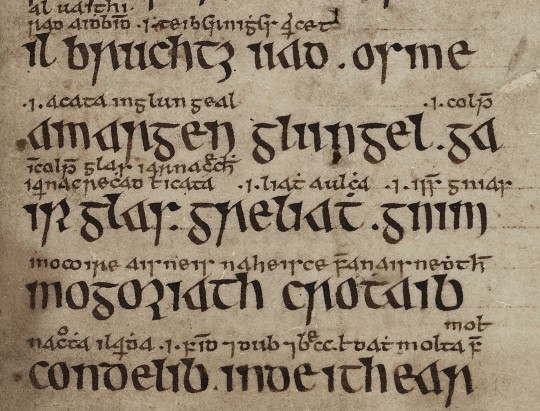
The text of the poem with interline glosses from Trinity College Dublin MS 1337/1
The word garrglas (blue-shanked) has a Middle Irish (c. 900-1200) gloss added by a later scribe, defining garrglas as: "a tattooed shank, or who has the blue tattooed shank" (Breatnach 1981).
Although Amairgen was a mythical figure, the position ollamh was not. An ollamh was the highest rank of poet in medieval Ireland, considered worthy of the same honor-price as a king (Carey 1997, Breatnach 1981). The fact that a man of such esteemed status introduces himself with the descriptor 'blue-shanked' suggests that tattoos were a respectable thing to have in early medieval Ireland.
The leg tattoos are also mentioned c. 900 CE in Cormac’s Glossary. It defines feirenn as "a thong which is about the calf of a man whence ‘a tattooed thong is tattooed about [the] calf’" (translation from MacQuarrie 1997)
The Irish legal text Uraicecht Becc, dated to the 9th or early 10th c., includes the word creccoire on a list of low-status occupations (Szacillo 2012, MacNeill 1924). A gloss defines it as: crechad glass ar na roscaib, a phrase which Szacillo interprets as meaning "making grey-blue sore (tattooing) on the eyes" (2012). This sounds rather strange, but another early Irish text clarifies it.
The Vita sancti Colmani abbatis de Land Elo written around the 8th-9th centuries (Szacillo 2012) contains the following episode:
On another time, St Colmán, looking upon his brother, who was the son of Beugne, saw that the lids of his eyes had been secretly painted with the hyacinth colour, as it was in the custom; and it was a great offence at St Colmán’s. He said to his brother: ‘May your eyes not see the light in your life (any more). And from that hour he was blind, seeing nothing until (his) death. (translation from Szacillo 2012).
The original Latin phrase describing what so offended St Colmán "palpebre oculorum illius latenter iacinto colore" does not contain the verb paint (pingo). It just says his eyelids were hyacinth (blue) colored. This passage together with the gloss from the Uraicecht Becc implies that there was a custom of tattooing people's eyelids blue in early medieval Ireland. A creccoire* was therefore a professional eyelid tattooer or a tattoo artist.
A possible third reference to tattooing the area around the eye is found in a list of Old Irish kennings. The kenning for the letter 'B' translates as 'Beauty of the eyebrow.' This kenning is glossed with the word crecad/creccad (McManus 1988). Crecad could be translated as cauterizing, branding, or tattooing (eDIL). McManus suggests "adornment (by tattooing) of the eyebrow" as a plausible interpretation of how crecad relates to the beauty of the eyebrow (1988). The precise date of this text is not known (McManus 1988), but Old Irish was used c. 600-900 CE, meaning this text is of a similar date to the other Irish references to tattoos.
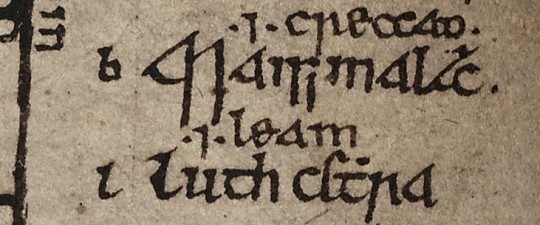
Kenning of the letter 'b' with gloss from TCD MS 1337/1
There is a sharp contrast between the association of tattoos with a venerated figure in 'The Caldron of Poesy', and their association with low-status work and divine punishment in the Uraicecht Becc and the Vita. This indicates that there was a shift in the cultural attitude towards tattoos in Ireland during the 7th-9th centuries. The fact that a Christian saint considered getting tattoos a big enough offense to punish his own brother with blindness suggests that tattooing might have been a pagan practice which gradually got pushed out by the Catholic Church. This timeline is consistent with the 786 CE report of the papal legates condemning the pagan practice of tattooing in Great Britain (MacQuarrie 1997).
There are some mentions of tattooing in Lebor Gabála Érenn, but the information largely appears to be borrowed from Isidore of Seville (MacQuarrie 1997). The fact that the writers of LGE just regurgitated Isidore's meager descriptions of Pictish and Scottish (ie Irish) tattooing without adding any details, such as the designs used or which parts of the body were tattooed, makes me think that Insular tattooing practices had passed out of living memory by the time the book was written in the 11th century.
*There is some etymological controversy over this term. Some have suggested that the Old Irish word for eyelid-tattooer should actually be crechaire. more info Even if this hypothesis is correct, and the scribe who wrote the gloss on creccoire mistook it for crechaire, this doesn't contradict my argument. The scribe clearly believed that eyelid-tattooer belonged on a list of low-status occupations.
Discussion:
Like Julius Cesar in the last post, Herodian of Antioch c. 208 CE makes some dubious claims of Celtic barbarism, stating that the Britons were: "Strangers to clothing, the Britons wear ornaments of iron at their waists and throats; considering iron a symbol of wealth, they value this metal as other barbarians value gold" (translation from MacQuarrie 1997). If the Britons wore nothing but iron jewelry, then why did they have brass torcs and 5,000 objects that look like they're meant to attach to fabric, Herodian?
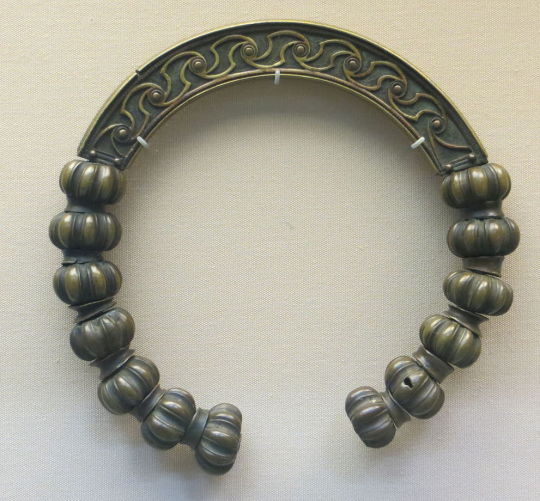
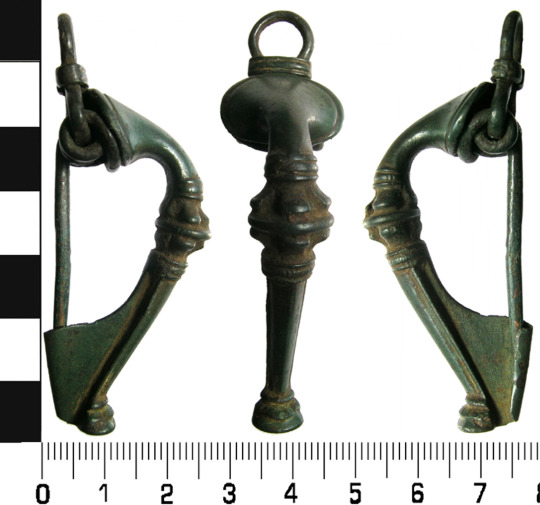
Brass torc from Lochar Moss, Scotland c. 50-200 CE. Romano-British trumpet brooch from Cumbria c. 75-175 CE. image from the Portable Antiquities Scheme.
Trumpet brooches are a Roman Era artifact invented in Britain, that were probably pinned to people's clothing. more info
Although Herodian and Solinus both make dubious claims, there are enough differences between them to indicate that they had 2 separate sources of information, and one was not just parroting the other. This combined with the fact that we have more-reliable sources from later centuries confirming the existence of tattoos in the British Isles makes it probable that there was at least a grain of truth to their claims of tattooing.
There is a common belief that the name Pict originated from the Latin pictus (painted), because the Picts had 'painted' or tattooed bodies. The Romans first used the name Pict to refer to inhabitants of Britain in 297 CE (Ware 2021), but the first mention of Pictish tattoos came in 402 CE (Carr 2005), and the first explicit statement that the name Pict was derived from the Picts' tattooed bodies came from Isidore of Seville c. 600 CE (MacQuarrie 1997). Unless someone can find an earlier source for this alleged etymology than Isidore, I am extremely skeptical of it.
Summary of the written evidence:
Some time between c. 79 CE (Pliny the Elder) and c. 208 CE (Herodian of Antioch) the practice of body art in Great Britain changed from staining or painting the skin to tattooing. Third century Celtic Briton tattoo designs depicted animals. Pictish tattoos are first mentioned in the 5th century.
The earliest mention of Irish tattoos comes from Isidore of Seville in the early 6th c., but since it seems to have been a pre-Christian practice, it likely started earlier. Irish tattoos of the 8-9th centuries were placed on the area around the eye and on the legs. They were a bluish color. The 8th c. Anglo-Saxons also had tattoos.
Tattooing in Ireland probably ended by the early 10th c., possibly because of Christian condemnation. Exactly when tattooing ended in Great Britain is unclear, but in the 12th c., William of Malmesbury describes it as a thing of the past (MacQuarrie 1997). None of these sources give much detail as to what the tattoos looked like.
The Archaeology of Insular Ink:
In spite of the fact that tattooing was a longer-lasting, more wide-spread practice in the British Isles than body painting, there is less archaeological evidence for it. This may be because the common tools used for tattooing, needles or blades for puncturing the skin, pigments to make the ink, and dishes to hold the ink, all had other common uses in the Middle Ages that could make an archaeologist overlook their use in tattooing. The same needle that was used to sew a tunic could also have been used to tattoo a leg (Carr 2005). A group of small, toothed bronze plates from a Romano-British site at Chalton, Hampshire might have been tattoo chisels (Carr 2005) or they might have been used to make stitching holes in leather (Cunliffe 1977).
Although the pigment used to make tattoos may be difficult to identify at archaeological sites, other lines of evidence might give us an idea of what it was. Although the written sources tell us that Irish tattoos were blue, the popular modern belief that woad was the source of the tattoo pigment is, in my opinion, extremely unlikely for a couple of reasons:
1) Blue pigment from woad doesn't seem to work as tattoo ink. The modern tattoo artists who have tried to use it have found that it burns out of the person's skin, leaving a scar with no trace of blue in it (Lambert 2004).
2) None of the historical sources actually mention tattooing with woad. Julius Cesar and Pliny the Elder mention something that might have been woad, but they were talking about body paint, not tattoos. (see previous post) Isidore of Seville claimed that the Picts were tattooing themselves with "juices squeezed from native plants", but even assuming that Isidore is a reliable source, you can't get blue from woad by just squeezing the juice out of it. In order to get blue out of woad, you have to first steep the leaves, then discard the leaves and add a base like ammonia to the vat (Carr 2005). The resulting dye vat is not something any knowledgeable person would describe as plant juice, so either Isidore had no idea what he was talking about, or he is talking about something other than blue pigment from woad.
In my opinion, the most likely pigment for early Irish and British tattoos is charcoal. Early tattoos found on mummies from Europe and Siberia all contain charcoal and no other colored pigment. These tattoos range in date from c. 3300 BCE (Ötzi the Iceman) to c. 300 CE (Oglakhty grave 4) (Samadelli et al 2015, Pankova 2013).
Despite the fact that charcoal is black, it tends to look blueish when used in tattoos (Pankova 2013). Even modern black ink tattoos that use carbon black pigment (which is effectively a purer form of charcoal) tend to look increasingly blue as they age.
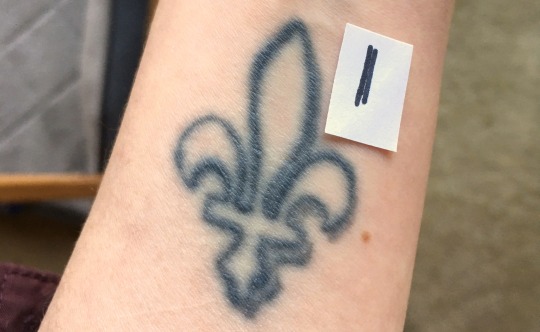
A 17-year-old tattoo in carbon black ink photographed with a swatch of black Sharpie on white printer paper.
The fact that charcoal-based tattoo inks continue to be used today, more than 5,000 years after the first charcoal tattoo was given, shows that charcoal is an effective, relatively safe tattoo pigment, unlike woad. Additionally, charcoal can be easily produced with wood fires, meaning it would have been a readily available material for tattoo artists in the early medieval British Isles. We would need more direct evidence, like a tattooed body from the British Isles, to confirm its use though.
As of June 2024, there have been at least 279 bog bodies* found in the British Isles (Ó Floinn 1995, Turner 1995, Cowie, Picken, Wallace 2011, Giles 2020, BBC 2024), a handful of which have made it into modern museum collections. Unfortunately, tattoos have not been found on any of them. (We don't have a full scientific analysis for the 2023 Bellaghy find yet though.)
*This number includes some finds from fens. It does not include the Cladh Hallan composite mummies.
Tattoos in period art?
It has been suggested that the man fight a beast on Book of Kells f. 130r may be naked and covered in tattoos (MacQuarrie 1997). However, Dress in Ireland author Mairead Dunlevy interprets this illustration as a man wearing a jacket and trews (Dunlevy 1989). Looking at some of the other figures in the Book of Kells, I agree with Dunlevy. F. 97v shows the same long, fitted sleeves and round neckline. F. 292r has long, fitted leg coverings, presumably trews, and also long sleeves. The interlace and dot motifs on f. 130r's legs may be embroidery. Embroidered garments were a status symbol in early medieval Ireland (Dunlevy 1989).

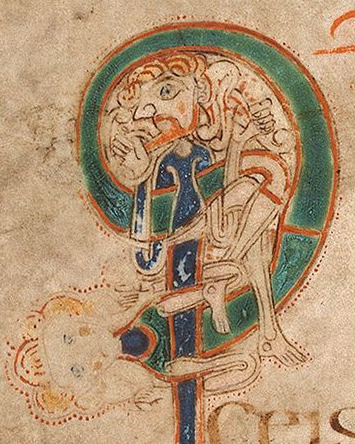
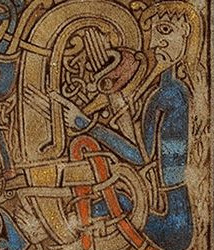
Left to right: Book of Kells folios 130r, 97v, 292r
A couple of sculptures in County Fermanagh might sport depictions of Irish tattoos. The first, known as the Bishop stone, is in the Killadeas cemetery. It features a carved head with 2 marks on the left side of the face, a double line beside the mouth and a single line below the eye. These lines may represent tattoos.
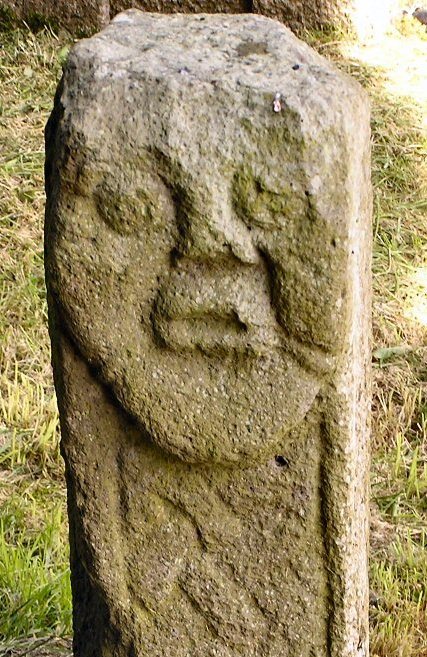

The second sculpture is the Janus figure on Boa Island. (So named because it has 2 faces; it's not Roman.) It has marks under the right eye and extending from the corner of the left eye that may be tattoos.
I cannot find a definitive date for the Bishop stone head, but it bears a strong resemblance to the nearby White Island church figures. The White Island figures are stylistically dated to the 9th-10th centuries and may come from a church that was destroyed by Vikings in 837 CE (Halpin and Newman 2006, Lowry-Corry 1959). The Janus figure is believed to be Iron Age or early medieval (Halpin and Newman 2006).
Conclusions:
Despite the fact that tattooing as a custom in the British Isles lasted for more than 500 years and was practiced by at least 3 different cultures, written sources remain our only solid evidence for it. With only a dozen sources, some of which probably copied each other, to cover this time span, there are huge gaps in our knowledge. The 4th century Picts may not have had the same tattoo designs, placements or reasons for getting tattooed as the 8th c. Irish or Anglo-Saxons. These sources only give us fragments of information on who got tattooed, where the tattoos were placed, what they looked like, how the tattoos were done, and why people got tattooed. Further complicating our limited information is the fact that most of the text sources come from foreigners and/or people who were prejudiced against tattooing, which calls their accuracy into question.
'The Cauldron of Posey' is one source that provides some detail while not showing prejudice against tattoos. The author of the poem was probably Christian, but the poem appears to have been written at a time when Pagan practices were still tolerated in Ireland. I have a complete translation of the poem along with a longer discussion of religious elements here.
Leave me a tip?
Bibliography:
BBC (2024). Bellaghy bog body: Human remains are 2,000 years old https://www.bbc.com/news/uk-northern-ireland-68092307
Breatnach, L. (1981). The Cauldron of Poesy. Ériu, 32(1981), 45-93. https://www.jstor.org/stable/30007454
Carey, J. (1997). The Three Things Required of a Poet. Ériu, 48(1997), 41-58. https://www.jstor.org/stable/30007956
Carr, Gillian. (2005). Woad, Tattooing and Identity in Later Iron Age and Early Roman Britain. Oxford Journal of Archaeology 24(3), 273–292. https://doi.org/10.1111/j.1468-0092.2005.00236.x
Cowie, T., Pickin, J. and Wallace, T. (2011). Bog bodies from Scotland: old finds, new records. Journal of Wetland Archaeology 10(1): 1–45.
Cunliffe, B. (1977) The Romano-British Village at Chalton, Hants. Proceedings of the Hampshire Field Club and Archaeological Society, 33(1977), 45-67.
Dunlevy, Mairead (1989). Dress in Ireland. B. T. Batsford LTD, London.
eDIL s.v. crechad https://dil.ie/12794
Giles, Melanie. (2020). Bog Bodies Face to face with the past. Manchester University Press, Manchester. https://library.oapen.org/viewer/web/viewer.html?file=/bitstream/handle/20.500.12657/46717/9781526150196_fullhl.pdf?sequence=1&isAllowed=y
Halpin, A., Newman, C. (2006). Ireland: An Oxford Archaeological Guide to Sites from Earliest Times to AD 1600. Oxford University Press, Oxford. https://archive.org/details/irelandoxfordarc0000halp/page/n3/mode/2up
Hoecherl, M. (2016). Controlling Colours: Function and Meaning of Colour in the British Iron Age. Archaeopress Publishing LTD, Oxford. https://www.google.com/books/edition/Controlling_Colours/WRteEAAAQBAJ?hl=en&gbpv=0
Lambert, S. K. (2004). The Problem of the Woad. Dunsgathan.net. https://dunsgathan.net/essays/woad.htm
Lowry-Corry, D. (1959). A Newly Discovered Statue at the Church on White Island, County Fermanagh. Ulster Journal of Archaeology, 22(1959), 59-66. https://www.jstor.org/stable/20567530
MacQuarrie, Charles. (1997). Insular Celtic tattooing: History, myth and metaphor. Etudes Celtiques, 33, 159-189. https://doi.org/10.3406/ecelt.1997.2117
McManus, D. (1988). Irish Letter-Names and Their Kennings. Ériu, 39(1988), 127-168. https://www.jstor.org/stable/30024135
Ó Floinn, R. (1995). Recent research into Irish bog bodies. In R. C. Turner and R. G. Scaife (eds) Bog Bodies: New Discoveries and New Perspectives (p. 137–45). British Museum Press, London. ISBN: 9780714123059
Pankova, S. (2013). One More Culture with Ancient Tattoo Tradition in Southern Siberia: Tattoos on a Mummy from the Oglakhty Burial Ground, 3rd-4th century AD. Zurich Studies in Archaeology, 9(2013), 75-86.
Samadelli, M., Melisc, M., Miccolic, M., Vigld, E.E., Zinka, A.R. (2015). Complete mapping of the tattoos of the 5300-year-old Tyrolean Iceman. Journal of Cultural Heritage, 16(2015), 753–758.
Story, Joanna (1995). Charlemagne and Northumbria : the in
fluence of Francia on Northumbrian politics in the later eighth and early ninth centuries. [Doctoral Thesis]. Durham University. http://etheses.dur.ac.uk/1460/
Szacillo, J. (2012). Irish hagiography and its dating: a study of the O'Donohue group of Irish saints' lives. [Doctoral Thesis]. Queen's University Belfast.
Turner, R.C. (1995). Resent Research into British Bog Bodies. In R. C. Turner and R. G. Scaife (eds) Bog Bodies: New Discoveries and New Perspectives (p. 221–34). British Museum Press, London. ISBN: 9780714123059
Ware, C. (2021). A Literary Commentary on Panegyrici Latini VI(7) An Oration Delivered Before the Emperor Constantine in Trier, ca. AD 310. Cambridge University Press, Cambridge. https://www.google.com/books/edition/A_Literary_Commentary_on_Panegyrici_Lati/oEwMEAAAQBAJ?hl=en&gbpv=0
#early medieval#roman era#pict#tattoos#ancient celts#apologies to people who wanted a shorter post#archaeology#art#anecdotes and observations#statutes and laws#irish history#gaelic ireland#medieval ireland#anglo saxon#insular celts#romano british
93 notes
·
View notes
Note
"everything else is like a plate of fleshy steel" let's just test Chrollo with a magnet atp 😭
sometimes in life, you just have to point at magnet at the world-renowned criminal and see what happens. science is a field of hypothesizing, testing, reflecting, and starting this process all over again in a neat circle. when there's so little for you to do, you have to get creative about entertaining yourself.
locating the magnet is the most difficult step, but after that, you're free to carry out your investigation. he'll observe with muted curiosity as the magnet exanimation commences. he's always wondering what you're up to and how the gears in your mind turn. although, realistically, he figures there will be a jab at his expense somewhere down the line.
when you're finished, he'll ask if you learned everything you needed to.
"unfortunately, yes. given how heartless you are, i was confident you were a robot. it seems another explanation is in order."
he considers giving you a stethoscope next.
146 notes
·
View notes
Text


OUGH. A warm-up doodle that turned into a color scheme study. I've struggled with palettes a long time and I think it's starting to click.
We're wrapping up our third arc and Tavosh [right, my PC Mimsi's (left) coworker and almost love interest] is finally back in game! The party's on their way back to home base and it's a few days' ride by carriage--I've left it up for interpretation whether Tavosh is putting his arm around Mimsi intentionally or not. It's early December in a southern location, so I wanted to go with some cute and cozy autumn vibes.
Tavosh belongs to GM @phillillillip though honestly at this point we might as well have joint custody.
Pillowfort
☆: *.♡ .* :☆
2023 | Please do not repost (reblogs welcome)
#hobgoblin#goblin girl#illustration#pathfinder#art#ttrpg#goblin#pathfinder: the exanimate harbinger#oc: mimsi morwaine#arc three
19 notes
·
View notes